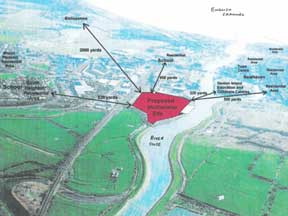Activists Take Over Incinerator Site
28.07.2008 17:21 | Climate Chaos | Ecology | Globalisation | South Coast
Activists took over the site of the proposed new incinerator plant in Newhaven. They entered the premises under the cover of darkness last night in an organised attempt at non-violent direct action, after resistance through democratic means failed them. Several protestors formed a barricade by superglue-ing themselves to the road in an attempt to prevent vehicle access, whilst on the site itself, other members of the group 'locked-on' to machinery in order to halt further activity. They claim to be exercising their democratic right to protest non-violently in a last-ditch attempt to promote their concerns about the consequences of incinerators on public health and safety.

The devastating health implications for the environment and those living or working within the (10-15 mile radius) fallout zone of the incinerator plant have been well documented by groups like Dove2000, and according to Dr. Neil Catman (former incinerator inspector and internationally recognised expert on toxic waste incineration),
'in licensing these incineration operations, the government is creating zones of sacrifice....I'm not just talking about people getting sick. I've seen them die. If the wind would blow the smoke towards the school on a Monday you'd see the children being at home sick on Tuesday and Wednesday. The schools near the incinerators had the highest absentee rates in the district. I met a lot of these children. I've seen them die of leukaemia, brain cancer and a host of other disorders'.
It is claimed that incinerators emit some of the most toxic and bioaccumulative air pollutants including acidic gases and fine dust particles which penetrate deep into the lungs causing respiratory disease and asthma; dioxins which suppress the immune system, cause cancer, and pose a particular problem for pregnant or breastfeeding mothers as they pass through to babies, readily reducing the rate of male births, causing hormonal disruption, learning difficulties and behavioural problems. Also emitted are nanoparticles and 2.5 micron particles which are known carcinogens able to migrate around the body, and a variety of dangerous heavy metals which affect the kidney and lungs, cause nerve and brain damage and adversely affect the central nervous system.
* (www.dove2000.org.uk). The decision to use incinerators for burning radioactive waste from nuclear power stations is also being considered.
By last year alone the cost of the project had soared to £145.7 million, with Brighton and Hove City Council and East Sussex County Council having collectively invested at least £2 million in legal fees to bring the project beyond the planning stage. There are a further 100-168 incinerators planned for use in the UK, though it appears that the Stop Incineration Now! network of protestors are determined to assert their belief that this money could be more advantageously spent on recycling initiatives to combat waste management problems more sustainably without creating further environmental problems for present and future generations.